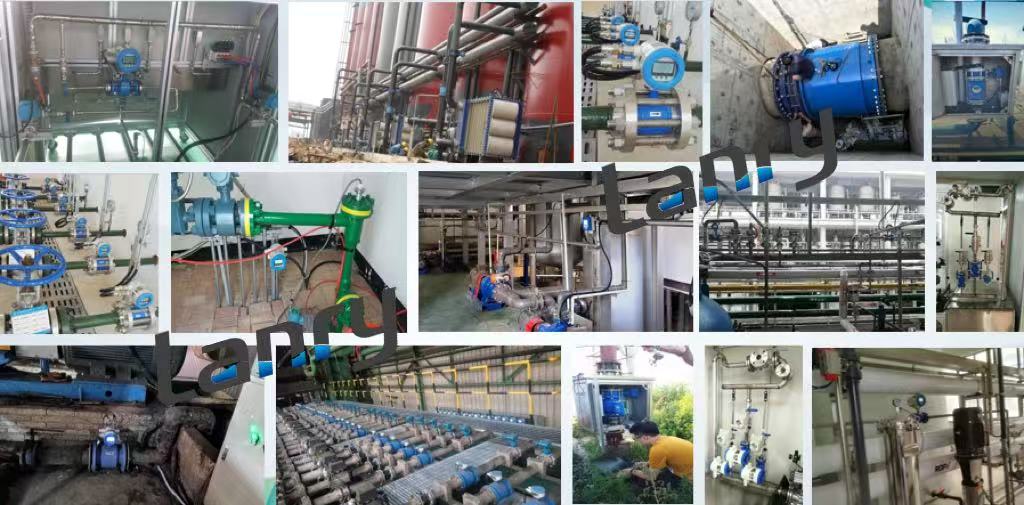Electromagnetic flowmeters are widely used in industrial processes for accurate flow measurement. However, there are several scenarios where their application may not be appropriate.
1. Non - Conductive Fluids
Electromagnetic flowmeters operate based on Faraday's law of electromagnetic induction. They require the fluid being measured to be electrically conductive. When a conductive fluid flows through a magnetic field, a voltage is induced across the diameter of the flow tube, which is proportional to the flow velocity of the fluid. For non - conductive fluids such as most hydrocarbons (e.g., gasoline, diesel), pure water in a highly deionized state, and many organic solvents, the induced voltage is either extremely low or non - existent. In such cases, the electromagnetic flowmeter cannot accurately measure the flow rate as it lacks the necessary conductive medium to generate the measurable induced voltage.
2. Fluids with High Solid Content or Abrasive Particles
Fluids containing a high concentration of solid particles or abrasive substances can pose significant problems for electromagnetic flowmeters. The inner lining of the flow tube in an electromagnetic flowmeter is crucial for the proper functioning of the meter. Abrasive particles in the fluid can gradually erode the lining over time. As the lining wears down, it can affect the accuracy of the induced voltage measurement. Additionally, solid particles may also cause blockages in the electrodes of the flowmeter. These electrodes are essential for detecting the induced voltage. Blockages can disrupt the electrical connection between the fluid and the electrodes, leading to inaccurate or erratic flow readings. For example, in mining slurry pipelines where the slurry contains large amounts of abrasive minerals, an electromagnetic flowmeter may not be the best choice as its lifespan and measurement accuracy would be severely compromised.
3. Low - Flow Conditions
Electromagnetic flowmeters have a certain minimum flow velocity below which their performance deteriorates. At very low flow rates, the induced voltage generated by the flowing fluid is extremely small. This small voltage can be easily affected by electrical noise and other interference sources. The signal - to - noise ratio becomes unfavorable, making it difficult for the meter to accurately distinguish the induced voltage related to the flow from the background noise. As a result, the measurement accuracy of the electromagnetic flowmeter in low - flow conditions is often poor, and it may not be able to provide reliable flow rate data. This is particularly relevant in applications where the flow rate varies widely and may drop to very low values for extended periods, such as in some small - scale chemical processes or in water supply systems during periods of low demand.
4. High - Temperature and High - Pressure Environments (Beyond Rated Limits)
Each electromagnetic flowmeter is designed to operate within specific temperature and pressure ranges. If the fluid temperature or pressure exceeds these rated limits, it can cause problems. High temperatures can affect the physical and electrical properties of the materials used in the flowmeter, such as the lining material and the insulation of the electrodes. The lining may expand, contract, or even degrade at high temperatures, which can lead to leaks or changes in the flow tube's geometry, thereby influencing the measurement accuracy. Similarly, high pressures can put excessive stress on the flow tube and its components. If the pressure is too high, it may cause the flow tube to deform or rupture, rendering the flowmeter inoperable. In applications involving extremely hot fluids, like in some high - temperature industrial furnaces, or in high - pressure pipelines in the oil and gas industry where the pressure can reach very high levels, an electromagnetic flowmeter may not be suitable unless it is specifically designed for such extreme conditions.
In conclusion, while electromagnetic flowmeters offer many advantages in flow measurement, it is important to carefully consider the nature of the fluid, the operating conditions, and the flow characteristics to determine whether they are the most appropriate choice. In the situations described above, alternative flow measurement technologies may be more suitable to ensure accurate and reliable flow rate determination.

Post time: Mar-10-2025

